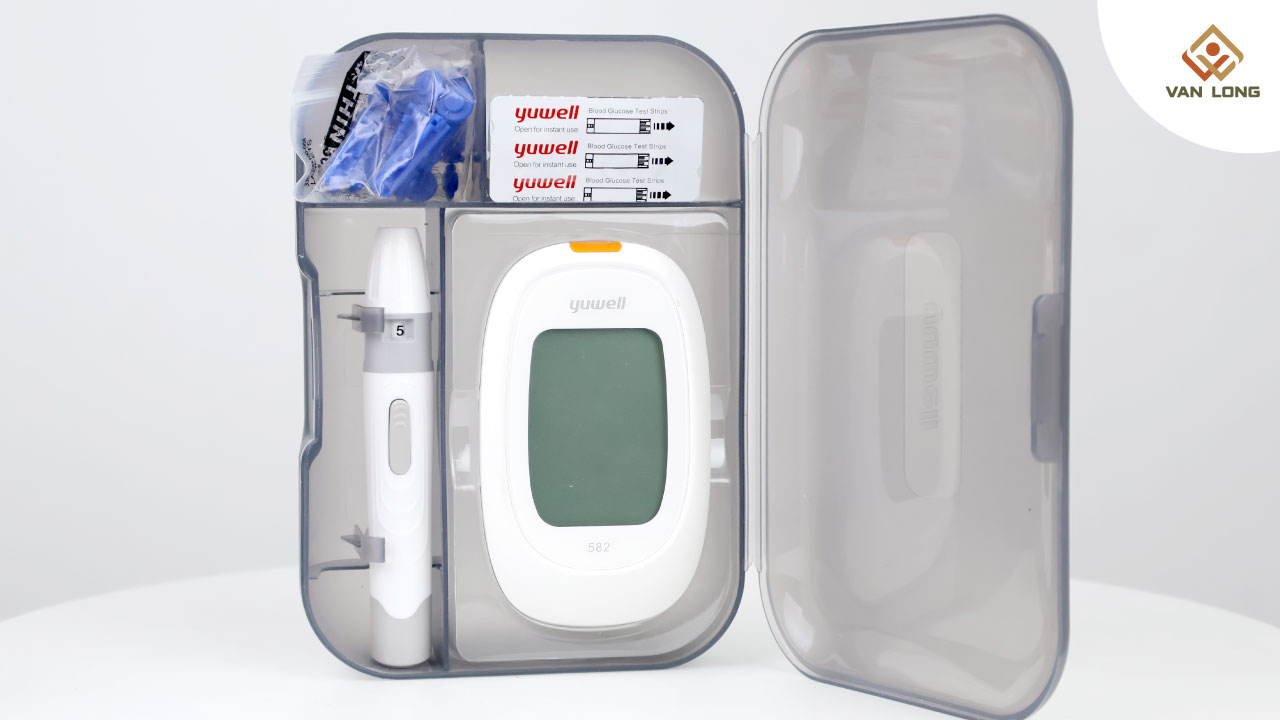Bệnh tiểu đường (hay còn gọi là đái tháo đường) đang ngày càng trở nên phổ biến, ảnh hưởng đến hàng triệu người trên toàn thế giới, trong đó có Việt Nam. Đây không chỉ là bệnh mạn tính nguy hiểm mà còn liên quan chặt chẽ đến nhiều biến chứng như suy thận, mù lòa, tim mạch và đột quỵ.
Một trong những câu hỏi được nhiều người quan tâm nhất là: tiểu đường có di truyền không? Nếu cha mẹ hoặc người thân trong gia đình mắc bệnh, liệu nguy cơ của bạn có cao hơn không? Câu trả lời là có, nhưng mức độ ảnh hưởng sẽ còn phụ thuộc vào nhiều yếu tố khác nhau như chế độ ăn uống, vận động, môi trường sống và cách theo dõi sức khỏe cá nhân.
Việc hiểu rõ bản chất di truyền của bệnh là bước đầu để bạn xây dựng lối sống phòng ngừa hiệu quả. Và trong quá trình đó, thiết bị theo dõi như máy đo đường huyết chính là công cụ không thể thiếu giúp bạn chủ động kiểm tra chỉ số đường huyết, điều chỉnh kịp thời và ngăn chặn các biến chứng nguy hiểm.

Theo nhiều nghiên cứu, bệnh tiểu đường có yếu tố di truyền, nhưng mức độ khác nhau tùy theo từng loại bệnh:
Tiểu đường tuýp 1 thường khởi phát từ sớm, do hệ miễn dịch tấn công các tế bào beta sản sinh insulin. Dù yếu tố di truyền có vai trò, nhưng không mạnh như ở tiểu đường tuýp 2. Nếu cha mẹ bị tuýp 1, khả năng con cái mắc bệnh tăng lên, đặc biệt nếu là người cha.
Tuy nhiên, chỉ khoảng 5–10% người mắc tiểu đường tuýp 1 có tiền sử gia đình mắc bệnh. Điều này cho thấy yếu tố môi trường, virus hoặc rối loạn miễn dịch cũng góp phần đáng kể.
Đây là dạng phổ biến nhất, chiếm khoảng 90% các ca tiểu đường. Nếu có người thân trực hệ (cha, mẹ, anh/chị/em) mắc bệnh thì nguy cơ mắc tuýp 2 của bạn có thể tăng gấp 2 đến 4 lần. Trường hợp cả cha và mẹ đều mắc bệnh, nguy cơ có thể tăng lên hơn 50%.
Các biến thể gen như TCF7L2, FTO, SLC30A8… được phát hiện liên quan đến nguy cơ kháng insulin và rối loạn chuyển hóa glucose. Tuy nhiên, yếu tố lối sống vẫn đóng vai trò lớn: một người có gene di truyền xấu nhưng có chế độ ăn lành mạnh và luyện tập đều đặn vẫn có thể tránh bệnh.
Phụ nữ có mẹ hoặc chị gái từng mắc tiểu đường thai kỳ dễ có nguy cơ tương tự trong thai kỳ. Sau sinh, họ cũng dễ tiến triển thành tiểu đường tuýp 2 nếu không kiểm soát chỉ số đường huyết nghiêm ngặt.

Bên cạnh yếu tố di truyền, có nhiều yếu tố nguy cơ khác khiến bạn dễ mắc tiểu đường nếu không kiểm soát tốt:
Cơ thể ít hoạt động sẽ làm giảm khả năng tiêu thụ glucose, tăng tình trạng kháng insulin – nguyên nhân chính dẫn đến tiểu đường tuýp 2.
Mỡ nội tạng dư thừa là yếu tố nguy cơ cao làm mất cân bằng hormone, tăng kháng insulin.
Các loại thực phẩm nhiều đường tinh luyện, nước ngọt, bánh kẹo... gây tăng đường huyết nhanh chóng, làm tụy phải làm việc quá tải.
Người bị cao huyết áp, cholesterol LDL cao hoặc triglyceride tăng cũng có nguy cơ bị rối loạn chuyển hóa glucose.
Người trên 45 tuổi có nguy cơ cao hơn do hoạt động của insulin và sự phục hồi tế bào beta suy giảm.
Phụ nữ từng sinh con > 4kg hoặc có tiền sử tiểu đường thai kỳ cũng có khả năng cao bị tiểu đường tuýp 2 về sau.

Trong bối cảnh bệnh tiểu đường ngày càng gia tăng, máy đo đường huyết tại nhà trở thành thiết bị y tế thiết yếu giúp người dùng theo dõi tình trạng đường huyết thường xuyên – đặc biệt với người có yếu tố di truyền.
Những người có nguy cơ cao (do di truyền hoặc thừa cân, ít vận động...) nên kiểm tra đường huyết vào buổi sáng hoặc sau ăn để theo dõi sự biến động bất thường, từ đó phát hiện sớm tiền tiểu đường.
Các dòng máy đo hiện nay như máy đo đường huyết điện tử có thể lưu trữ kết quả, kết nối app theo dõi, hiển thị kết quả trong vài giây.
Việc ghi nhận các kết quả cao bất thường sẽ giúp người dùng điều chỉnh chế độ ăn, tăng cường tập luyện hoặc đi khám sớm – tránh biến chứng.
Phát hiện sớm bằng máy đo đường huyết sẽ giúp bạn phòng hơn chữa, giảm nguy cơ nhập viện hoặc điều trị biến chứng.
Nhiều người hay nhầm lẫn giữa máy đo đường huyết và máy thử đường. Về bản chất, hai thuật ngữ này thường chỉ chung một thiết bị – tuy nhiên cần hiểu rõ để chọn mua phù hợp.
Tên gọi chính xác trong y khoa, dùng để đo chỉ số glucose trong máu mao mạch. Cần có máy chính, kim chích, và que thử đường (test strip).
Là cách gọi thông thường của người tiêu dùng, thực chất cũng là máy đo đường huyết. Một số người còn gọi các thiết bị thử glucose trong nước tiểu là máy thử đường, tuy nhiên phương pháp này kém chính xác và ít được khuyến khích.
Khi chọn mua, nên ưu tiên:

Việc hiểu chỉ số đường huyết và duy trì trong ngưỡng an toàn là điều quan trọng trong phòng và quản lý bệnh tiểu đường.
|
Thời điểm đo |
Chỉ số bình thường (mmol/L) |
Tiền tiểu đường |
Tiểu đường |
|
Khi đói (sáng sớm) |
4.0 – 5.6 |
5.7 – 6.9 |
≥ 7.0 |
|
2 giờ sau ăn |
< 7.8 |
7.8 – 11.0 |
≥ 11.1 |
|
HbA1c (xét nghiệm máu) |
< 5.7% |
5.7 – 6.4% |
≥ 6.5% |
Lưu ý khi đo tại nhà

Quản lý tốt bệnh tiểu đường là một quá trình lâu dài, đặc biệt nếu có yếu tố di truyền. Dưới đây là những giải pháp hữu ích bạn có thể áp dụng ngay tại nhà:
Kiểm tra ít nhất 1–2 lần/ngày nếu bạn đã bị tiểu đường, hoặc 2–3 lần/tuần nếu bạn ở nhóm có nguy cơ cao.
Đi bộ nhanh, đạp xe, yoga... ít nhất 30 phút mỗi ngày, 5 ngày/tuần giúp cải thiện độ nhạy insulin.
Stress làm tăng hormone cortisol – gián tiếp gây tăng đường huyết. Giữ tinh thần thư giãn là một phần quan trọng của quản lý bệnh.
Bên cạnh đường huyết, người bệnh nên theo dõi huyết áp, mỡ máu, chỉ số BMI...
Yếu tố di truyền có thể làm tăng nguy cơ mắc bệnh tiểu đường, nhưng không quyết định tất cả. Việc chủ động thay đổi lối sống, kết hợp với sử dụng các thiết bị hỗ trợ như máy đo đường huyết sẽ giúp bạn kiểm soát bệnh hiệu quả, thậm chí ngăn chặn hoàn toàn khả năng phát triển bệnh.
Hãy nhớ rằng: bạn không thể thay đổi gene, nhưng bạn hoàn toàn có thể thay đổi cách sống. Và đó chính là chìa khóa để bảo vệ sức khỏe bản thân và gia đình.
——————————
CÔNG TY TNHH PHÁT TRIỂN THƯƠNG MẠI DỊCH VỤ VÂN LONG
YOUR NEEDS - OUR BUSINESS
Hotline: (028) 3526 2468 / 098.484.0440
Email: cskh@vl-groups.com
Website: www.vl-groups.com
Địa chỉ:
- Văn phòng HCM: Tòa nhà Fosco, D35 + D36 - 40 Bà Huyện Thanh Quan, P.Xuân Hòa, TP. HCM
- Trung tâm bảo hành: 373/14 Nguyễn Kiệm, P.Đức Nhuận, TP.HCM
- Văn phòng Hà Nội: Khu VP Hồng Hà, 38.3/1 Ngõ 109 Trường Chinh, P.Phương Liệt, Q.Thanh Xuân, Hà Nội
- Kho Tổng: 938 Quốc Lộ 1A, P.Linh Xuân, TP.HCM
🌼 Shopee: https://shopee.vn/vanlonggroups
🌼 Tiktok: https://www.tiktok.com/@thietbichamsocsuckhoe
🌼 Tiki: https://tiki.vn/cua-hang/cham-soc-suc-khoe-van-long
🌼 Lazada: https://www.lazada.vn/shop/van-long-our-needs-your-business